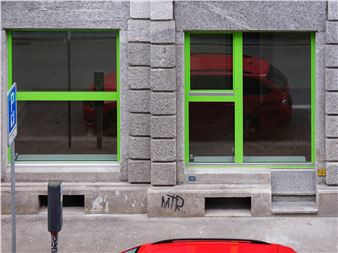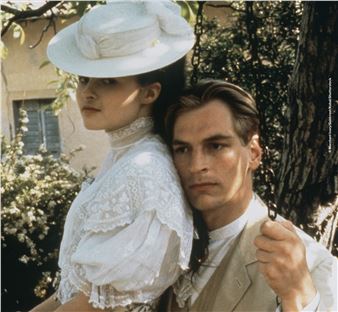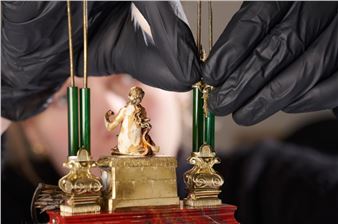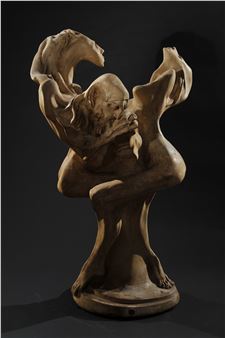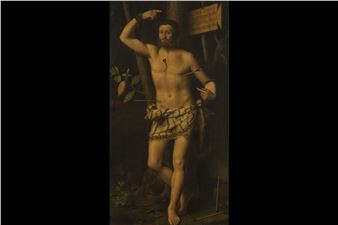Dmitry Trubin: Little Adults
A continuation of the drawing hand, the line is always peculiar to the artist вҖ“ just like the handwriting style shaped by an individualвҖҷs personality. The same holds true for Dmitry Trubin. His spunky and in every sense straightforward manner was definitely informed by the places where he was born and raised and lives to this day. Despite the harsh climate of the Arkhangelsk Oblast, the artist is fond of long walks along the Northern Dvina: to the accompaniment of the piercing winds blowing from the White Sea, he searches both for inspiration and for materials to use in his art objects, like tree branches, stones, and bogwood. Characteristically, his paintings are generally built around broken outlines. вҖҳI geometrise the world by using the straight line which I see as a purely human-made phenomenon since there are no such lines in nature,вҖҷ declares Trubin. вҖҳThe straight line embodies the absolute, hence is divine. ThatвҖҷs why I go for the straight line!вҖҷ
The Little Adults exhibition is a showcase of TrubinвҖҷs recent ChildrenвҖҷs Games series. Here, the artistвҖҷs distinct broken line evokes kidsвҖҷ drawings, further accentuating the naive childishness of his characters. Both the protagonists and their stories summon nostalgic recollections: looking at these pictures, one is bound to experience flashbacks, perhaps remembering the smell of the first school satchel or the springy feel of the bright rubber ball used in the game of dodgeball.
Needless to say, a game is not only a fun pastime, but a learning and development experience helping the child to acquire new skills by imitating adult behaviour. For instance, all characters in the Doll Play cycle behave differently: the artist seems to emphasise the disparateness of their personalities and predict what they will be like and how they will interact with others when they grow up. It is not by chance that the dolls the girls are holding look like their own small replicas, mimicking the way our children mirror us. As for the boys, they are much simpler in TrubinвҖҷs rendering: broad-faced and square-eyed, they appear to be free of any deep-seated anxieties. Ultimately, the exhibition is akin to a visual psychological test: investing his вҖҳlittle adultsвҖҷ with widely diverse temperaments, their creator seems to offer us a chance to select a character that most closely resembles us or our kids. Incidentally, one of the artworks featured in the show is a self-portrait: the Drawing Boy represents the artistвҖҷs idea of what he was like in his youth.
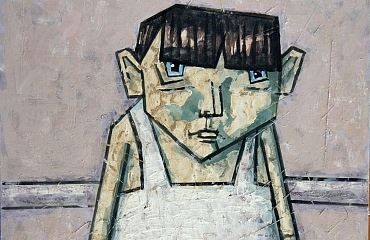
Recommended for you
A continuation of the drawing hand, the line is always peculiar to the artist вҖ“ just like the handwriting style shaped by an individualвҖҷs personality. The same holds true for Dmitry Trubin. His spunky and in every sense straightforward manner was definitely informed by the places where he was born and raised and lives to this day. Despite the harsh climate of the Arkhangelsk Oblast, the artist is fond of long walks along the Northern Dvina: to the accompaniment of the piercing winds blowing from the White Sea, he searches both for inspiration and for materials to use in his art objects, like tree branches, stones, and bogwood. Characteristically, his paintings are generally built around broken outlines. вҖҳI geometrise the world by using the straight line which I see as a purely human-made phenomenon since there are no such lines in nature,вҖҷ declares Trubin. вҖҳThe straight line embodies the absolute, hence is divine. ThatвҖҷs why I go for the straight line!вҖҷ
The Little Adults exhibition is a showcase of TrubinвҖҷs recent ChildrenвҖҷs Games series. Here, the artistвҖҷs distinct broken line evokes kidsвҖҷ drawings, further accentuating the naive childishness of his characters. Both the protagonists and their stories summon nostalgic recollections: looking at these pictures, one is bound to experience flashbacks, perhaps remembering the smell of the first school satchel or the springy feel of the bright rubber ball used in the game of dodgeball.
Needless to say, a game is not only a fun pastime, but a learning and development experience helping the child to acquire new skills by imitating adult behaviour. For instance, all characters in the Doll Play cycle behave differently: the artist seems to emphasise the disparateness of their personalities and predict what they will be like and how they will interact with others when they grow up. It is not by chance that the dolls the girls are holding look like their own small replicas, mimicking the way our children mirror us. As for the boys, they are much simpler in TrubinвҖҷs rendering: broad-faced and square-eyed, they appear to be free of any deep-seated anxieties. Ultimately, the exhibition is akin to a visual psychological test: investing his вҖҳlittle adultsвҖҷ with widely diverse temperaments, their creator seems to offer us a chance to select a character that most closely resembles us or our kids. Incidentally, one of the artworks featured in the show is a self-portrait: the Drawing Boy represents the artistвҖҷs idea of what he was like in his youth.
Artists on show
Contact details


 ARTISTS
ARTISTS







